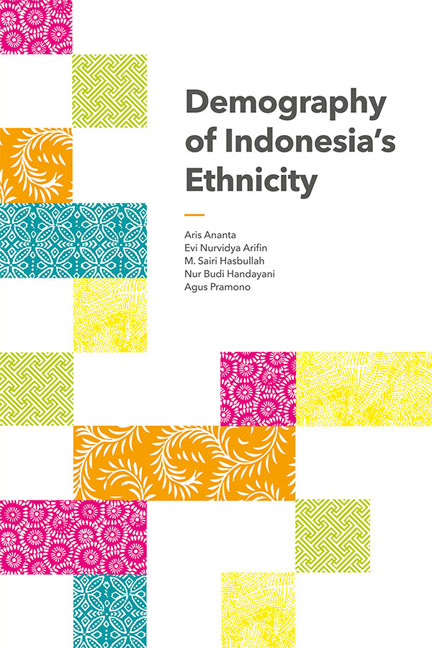Book contents
- Frontmatter
- Contents
- List of Tables
- List of Figures
- Foreword
- Acknowledgements
- 1 CHANGING INDONESIA: An Introduction
- 2 COMPLEXITY OF STATISTICS ON ETHNICITY: Concept, Data and Method of Analysis
- 3 THE NEW CLASSIFICATION: Uncovering Diversity
- 4 ETHNIC DIVERSITY: New Demographic Evidence
- 5 THE FIFTEEN LARGEST ETHNIC GROUPS: Age-Sex Structure and Geographical Distribution
- 6 CHANGE IN SIZE AND COMPOSITION OF ETHNIC GROUPS: Indonesia, 2000–2010
- 7 RELIGION AND LANGUAGE: Two Important Ethnic Markers
- References
- Appendix 1
- Appendix 2
- Index
- About the Authors
7 - RELIGION AND LANGUAGE: Two Important Ethnic Markers
Published online by Cambridge University Press: 10 October 2017
- Frontmatter
- Contents
- List of Tables
- List of Figures
- Foreword
- Acknowledgements
- 1 CHANGING INDONESIA: An Introduction
- 2 COMPLEXITY OF STATISTICS ON ETHNICITY: Concept, Data and Method of Analysis
- 3 THE NEW CLASSIFICATION: Uncovering Diversity
- 4 ETHNIC DIVERSITY: New Demographic Evidence
- 5 THE FIFTEEN LARGEST ETHNIC GROUPS: Age-Sex Structure and Geographical Distribution
- 6 CHANGE IN SIZE AND COMPOSITION OF ETHNIC GROUPS: Indonesia, 2000–2010
- 7 RELIGION AND LANGUAGE: Two Important Ethnic Markers
- References
- Appendix 1
- Appendix 2
- Index
- About the Authors
Summary
Earlier chapters have shown the richness of Indonesia in terms of its ethnic groups: the ethnic composition at the national level, the variation of the ethnic composition at the provincial level and the dynamics of ethnic composition across time. As religion and language are closely intertwined with ethnicity and the data are available from the 2010 population census, this chapter examines the religions and languages of each of the fifteen largest ethnic groups in Indonesia. This is the first detailed statistical information on the religion and language of ethnic groups ever published for the whole of Indonesia and its fifteen largest ethnic groups. However, this chapter does not assume that there is any meaningful relationship between religion and the usual language spoken at home.
This chapter begins by examining the religious composition of Indonesia, including politically inherited problems concerning statistics on religion. Although Indonesia is well known as a Muslim majority country, this chapter examines and shows the spatial distribution of religious followers, that there is a considerable variation of religious compositions across provinces and within each province. Furthermore, this chapter studies the religions of each of the fifteen largest ethnic groups, the first quantitative measurement of religions amongst ethnic groups in Indonesia. It shows the composition of religious followers in each of the ethnic groups. This section provides an interesting answer to whether or not, for example, there is a significant percentage of Sundanese recording themselves as embracing Protestantism. Do the Chinese embrace only Buddhism or Christianity? What percentage of the Chinese Indonesians are Muslims?
This chapter also studies the composition of groups of language speakers in Indonesia, which may be different from that of ethnic groups. It also analyses what languages each of the fifteen largest ethnic groups speak daily at home. It is the first quantitative analysis on the language of ethnic groups in Indonesia. For example, it calculates the percentage of Javanese, the largest ethnic group in Indonesia, who speak their own language, who speak Bahasa Indonesia, the national language and/or who speak some other languages. Another example is the language proficiency of the Chinese Indonesians. How many Chinese speak Bahasa Indonesia, how many of them speak their own language (Chinese) and/or how many speak some other local languages, such as Javanese?
- Type
- Chapter
- Information
- Demography of Indonesia's Ethnicity , pp. 253 - 302Publisher: ISEAS–Yusof Ishak InstitutePrint publication year: 2014

